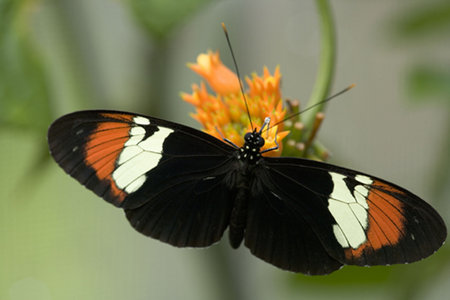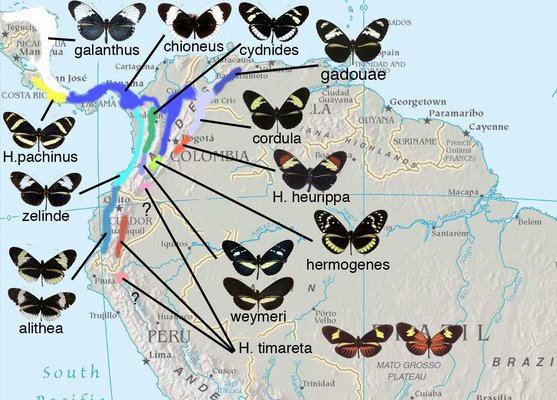Heliconius heurippa
Andrew V. Z. Brower and Margarita BeltránIntroduction
Heliconius heurippa, apparently a cognate of H. cydno (Brower 1994, 1996; Beltrán et al. 2007), is distributed on the eastern slopes of the Andes in Dpto. Meta, Colombia, where it is parapatric with H. melpomene melpomene on an elevational gradient (Benson et al. 1976). It has been hypothesized to be of hybrid origin between that species and H. cydno cordula (Salazar et al. 2005; Mavarez et al. 2006).
H. heurippa does not bear a close mimetic resemblance to any other Heliconius species.
Etymology: Heurippa is the finder of horses (Heurippe).
Characteristics
Early stages: Eggs are yellow and approximately 1.6 x 1 mm (h x w). Females usually place eggs singly on growing shoots of the host plant. Mature larvae have a white body with black spots, black scoli and the head is orange, length is around 1.9 cm. Caterpillars are gregarious in small numbers. (Brown, 1981).
Habits
H. heurippa occurs from 400 to 2,400 m in montane forest. Usually individuals fly rapidly and in the lower story. Females mate multiply and adults roost solitarily at night at 2-10 m above ground on twigs or tendrils.
Hostplant: H. heurippa is polyphagous and larvae feed primarily on plants from the subgenus Granadilla from Quadrangulares, Digitales, Laurifoliae sections (Passifloraceae) (Brown, 1981).
References
Beltrán, M., Jiggins, C. D., Brower, A. V. Z., Bermingham, E. & Mallet, J. 2007 Do pollen feeding, pupal-mating and larval gregariousness have a single origin in Heliconius butterflies? Inferences from multilocus DNA sequence data. Biol. J. Linn. Soc. 92, 221-239.
Benson, W. W., Brown, K. S., Jr. & Gilbert, L. E. 1976. Coevolution of plants and herbivores: passion flower butterflies. Evolution 29, 659-680.
Brower, A. V. Z. 1994 Phylogeny of Heliconius butterflies inferred from mitochondrial DNA sequences (Lepidoptera: Nymphalidae). Mol. Phylogenet. Evol. 3, 159-174.
Brower, A. V. Z. 1996 A new mimetic species of Heliconius (Lepidoptera: Nymphalidae), from southeastern Colombia, as revealed by cladistic analysis of mitochondrial DNA sequences. Zool. J. Linn. Soc. 116, 317-332.
Brown K. S. 1981 The Biology of Heliconius and Related Genera. Annual Review of Entomology 26, 427-456.
Gilbert LE. 2003. Adaptive novelty through introgression in Heliconius wing patterns: evidence for a shared genetic "tool box" from synthetic hybrid zones and a theory of diversification. In: Boggs CL, Watt WB and Ehrlich PR, eds. Butterflies: Ecology and evolution taking flight. Chicago: University of Chicago Press. 281-318.
"Heurippe." Artemis titles. http://www.theoi.com/Cult/ArtemisTitles.html [Accessed May 22, 2008].
Hewitson W C. 1854. Illustrations of new species of exotic butterflies, selected chiefly from the collections of W. Wilson Saunders and William C. Hewitson. London, John Van Voorst.(9): [13-14], [25-26], [83-84], pls. [7], [13], [42] (2 January 1854), (10): [87-90], [97-98], pls. [44-45], [49] (3 April 1854)
Mavarez J, Salazar CA, Bermingham E, Salcedo C, Jiggins CD, and Linares M. 2006. Speciation by hybridization in Heliconius butterflies. Nature 441: 868-871 , 11 supplementary pages.
Salazar CA, Jiggins CD, Arias CF, Tobler A, Bermingham E, and Linares M. 2005. Hybrid incompatibility is consistent with a hybrid origin of Heliconius heurippa Hewitson from its close relatives, Heliconius cydno Doubleday and Heliconius melpomene Linnaeus. Journal of Evolutionary Biology 18: 247-256.
Mavárez, J., Salazar, C., Bermingham, E., Salcedo, C., Jiggins, CD., Linares, M. 2006. Speciation by hybridization in Heliconius butterflies Nature. 441: 868-871.
Information on the Internet
- Recreation Of Butterfly Speciation Event. Terradaily Jun 16, 2006.
Title Illustrations

| Scientific Name | Heliconius heurippa |
|---|---|
| Specimen Condition | Live Specimen |
| Source | University of Cambridge Butterfly genetics group |
| Copyright | © Juan Gillermo Montańés and Mauricio Linares |
About This Page

Middle Tennessee State University, Murfreesboro, Tennessee, USA

University of Cambridge, Cambridge, UK
Correspondence regarding this page should be directed to Andrew V. Z. Brower at and Margarita Beltrán at
Page copyright © 2010 and
 Page: Tree of Life
Heliconius heurippa .
Authored by
Andrew V. Z. Brower and Margarita Beltrán.
The TEXT of this page is licensed under the
Creative Commons Attribution License - Version 3.0. Note that images and other media
featured on this page are each governed by their own license, and they may or may not be available
for reuse. Click on an image or a media link to access the media data window, which provides the
relevant licensing information. For the general terms and conditions of ToL material reuse and
redistribution, please see the Tree of Life Copyright
Policies.
Page: Tree of Life
Heliconius heurippa .
Authored by
Andrew V. Z. Brower and Margarita Beltrán.
The TEXT of this page is licensed under the
Creative Commons Attribution License - Version 3.0. Note that images and other media
featured on this page are each governed by their own license, and they may or may not be available
for reuse. Click on an image or a media link to access the media data window, which provides the
relevant licensing information. For the general terms and conditions of ToL material reuse and
redistribution, please see the Tree of Life Copyright
Policies.
- First online 19 February 2007
- Content changed 04 September 2008
Citing this page:
Brower, Andrew V. Z. and Margarita Beltrán. 2008. Heliconius heurippa . Version 04 September 2008 (under construction). http://tolweb.org/Heliconius_heurippa/72255/2008.09.04 in The Tree of Life Web Project, http://tolweb.org/









 Go to quick links
Go to quick search
Go to navigation for this section of the ToL site
Go to detailed links for the ToL site
Go to quick links
Go to quick search
Go to navigation for this section of the ToL site
Go to detailed links for the ToL site